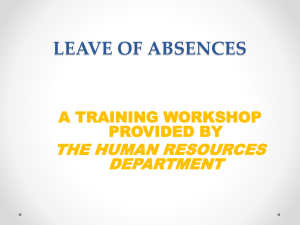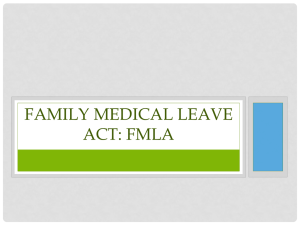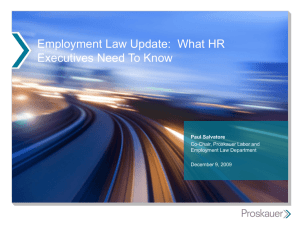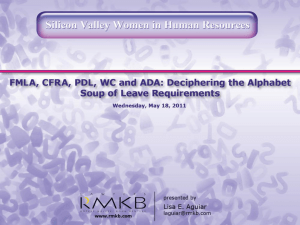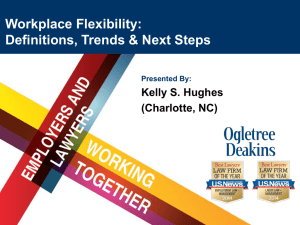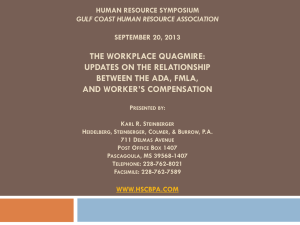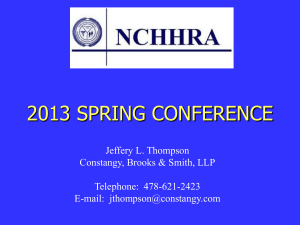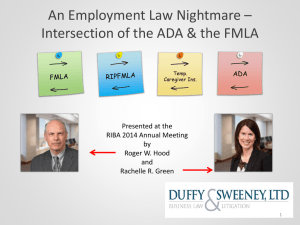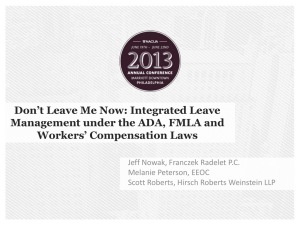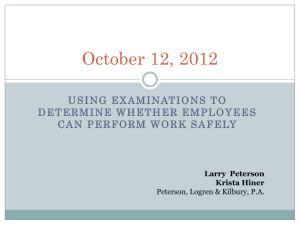For Example (cont.) - HR Compliance Expert
advertisement
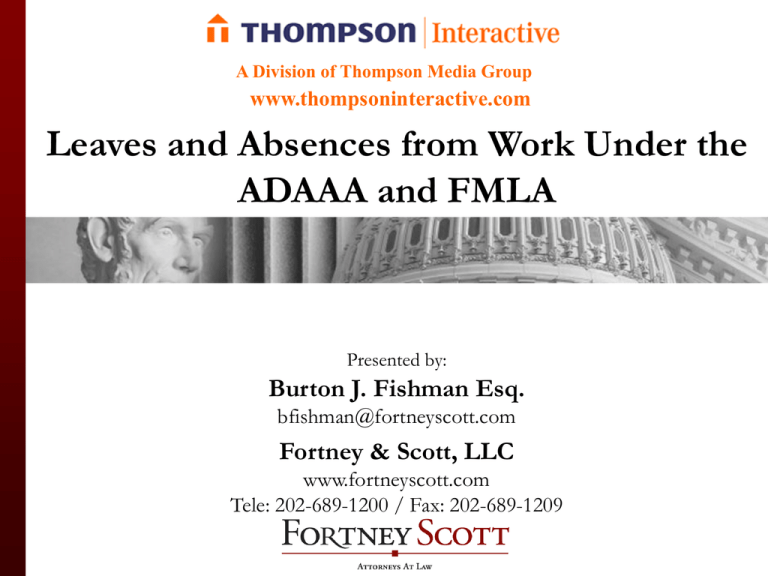
A Division of Thompson Media Group www.thompsoninteractive.com Leaves and Absences from Work Under the ADAAA and FMLA Presented by: Burton J. Fishman Esq. bfishman@fortneyscott.com Fortney & Scott, LLC www.fortneyscott.com Tele: 202-689-1200 / Fax: 202-689-1209 Important Legal Notice This presentation is to provide general information and updates regarding rights and obligations for federal contractors. These materials are not intended to provide legal advice. Federal contractors’ representatives should consult either with their in-house counsel or, as directed, with an experienced employment attorney for legal advice about whether, based on their specific facts and circumstances, their company complies with the applicable federal and state laws and regulations. 2 © FortneyScott 2011 The Dilemma Amendments to the ADA create new opportunities for employees to be absent from work even without sick leave and even if the ailment doesn’t qualify for the FMLA. What can you do? First, some background. 3 © FortneyScott 2011 Amendments to the ADA Broadens the definition of disability by: Expanding the types of Major Life Activities. Broadening the definition of “substantially limits.” Removing the consideration of mitigating measures on a person’s impairment. Impairments that are episodic or in remission will be disabilities if such impairments otherwise meet the definition of “disabled” while active. Expands definition of “regarded as” disabled. No accommodation of “regarded as” disabilities. Retains “undue hardship” exception. 4 © FortneyScott 2011 Major Life Activities “Working” retained as a major life activity. Controversy about its inclusion continues. If inability to do a single job yields as accommodation, then is a transfer to a different, even preferred job, “reasonable?” List of Major Life Activities has greatly increased. 5 © FortneyScott 2011 Major Life Activities (cont.) Major Life Activities include the following actions: Caring for oneself Performing Manual Tasks Seeing Hearing Eating Sleeping Walking Standing Lifting Speaking Bending Learning Breathing Concentrating Reading Communicating Thinking Performing Manual Tasks Working Hearing Sleeping Breathing Standing Reading Bending Sitting* Reaching* Working * Added by EEOC Interacting with others* 6 © FortneyScott 2011 Major Life Activities (cont.) Expanded Major Life Activities to include the following bodily functions: Immune system Brain Normal cell growth Respiratory Digestive Circulatory Bowel Endocrine Bladder Reproductive Neurological Cardiovascular* Special sense organs & skin* Lymphatic* Genitourinary* Hemic* Musculoskeletal* Many functions have no relation to or even likely manifestation at work. *Added by EEOC 7 © FortneyScott 2011 Summary of ADAAA Basics ADA Employers of 15 or more are covered Disability required, many are life-long; Many accommodations available, including leave but cannot create undue hardship; Leave is concurrent with FMLA leave, but can be longer than FMLA leave AND can be added to FMLA leave IF a disability is involved; Leave is supposed to be curative, thus, indefinite leave is usually “unreasonable”; and Return to same job required, with or without accommodation, unless employee cannot perform it; in that case, assignment to a vacant position must be considered. 8 © FortneyScott 2011 When is a Hardship Undue? If your policies permit the accommodation (e.g., length of leave), not undue. If you have done it in the past, probably not undue (absent change of policy). If it disrupts work process-sales territory uncovered; other workers over-burdened; leaves essential functions undone or shifts them to other employees-likely undue. Relationship of accommodation to essential functions of job is a useful guide. 9 © FortneyScott 2011 Summary of FMLA Basics FMLA: Employers of 50 or more are covered Only a “serious health condition” required; not intended to be a high standard; Leave is only benefit but need not be “reasonable”; 12-week fixed maximum leave; Condition can be chronic; Leave can be intermittent; and Return to same or similar job guaranteed within 12-week period, but no reassignment or other accommodation required. 10 © FortneyScott 2011 What is a “Serious Health Condition?” Physical or mental impairment requiring: In-patient care, including any period of incapacity or subsequent treatment in connection with in-patient care, or; Continuing treatment by a health care provider. 11 © FortneyScott 2011 Intermittent Leave Non-emergency leave must be taken in manner that does not unduly disrupt business operations. Employee may take intermittent leave or reduced work hours when medically necessary and leave may be taken in the smallest time period offered for any other leave (if not more than one hour). May limit to leave for treatment or because incapacitated. 12 © FortneyScott 2011 Why does this matter? Uncontrollable and unpredictable absences have profound impact on productivity and profitability. In comments on the FMLA, employers identified abuses of FMLA, particularly intermittent leave, as their most serious leave problem. The ADAAA, which applies to employers of only 15, will create numerous new opportunities for mandated absences – some not even permitted under the FMLA. 13 © FortneyScott 2011 Why does this matter? (cont.) Because of the expansion of the definition of disability under the ADAAA, some differences between the FMLA and the ADA have been reduced or have disappeared. Anticipate requests for extended leave under the ADAAA as FMLA leave expires. 14 © FortneyScott 2011 For Example An employee has exhausted her sick leave but has a doctor’s note requiring fertility treatments, twice a month, two days in a row. This is not a serious health condition BUT substantial impairments to a person’s reproductive function is named as a disability. 15 © FortneyScott 2011 For Example (cont.) Salesman needs 13 weeks or more to recuperate from an ailment, during which time his territory would be “uncovered.” Would you grant the leave or is this an undue hardship? Would you consider a temporary transfer of another salesperson? What if it were only 12 weeks and under FMLA? 16 © FortneyScott 2011 For Example (cont.) An employee with an ADA disability has taken 12 weeks of FMLA leave. There is no other leave option. He notifies his employer that he is ready to return to work, but he no longer is able to perform the essential functions of his position or an equivalent position. What would you do? 17 © FortneyScott 2011 For Example (cont.) An employee with an ADA disability requests that she be excused from work one day a week for the next six months because of her disability, but this will cause an undue hardship under the ADA. She also is eligible for FMLA. What would you do? 18 © FortneyScott 2011 For Example (cont.) When is an indefinite leave an undue hardship and when is it not? Example A: A specialized researcher requests leave for treatment of her disability but cannot provide a fixed date of return. 19 © FortneyScott 2011 For Example (cont.) When is an indefinite leave an undue hardship and when is it not? Example B: An employee requests twelve weeks of leave for surgery for his disability. The employer grants the request. During surgery, serious complications arise that require a lengthier period of recuperation than originally anticipated, as well as additional surgery. The employee contacts the employer after six weeks of leave to ask for an additional ten to eighteen weeks of leave (i.e., a total of 22 to 30 weeks of leave). 20 © FortneyScott 2011 How Can You Prepare? Re-Examine your Job Descriptions. An accommodation helps someone perform the essential functions of the job; it does not eliminate essential functions. So, look over list of Major Life Activities and determine which ones play a role in your jobs and in your workplace. If “thinking,” “concentrating,” “interacting with others,” and other basic elements, such as working to deadline, working under stress, coming to work regularly and promptly, are essential functions, write them in. 21 © FortneyScott 2011 How Can You Prepare? (cont.) Know your rights under the FMLA Use the Forms provided by the DOL and add whatever other forms you think will help you monitor FMLA use. When can you get a new medical certification? When can you influence use of intermittent leave? Remember, you designate a leave as eligible for FMLA. Adapt DOL forms for ADA 22 © FortneyScott 2011 How Can You Prepare? (cont.) Focus on the Interactive Dialogue. Can you accommodate? Because the new emphasis is on conduct, not definitions, your conduct is more critical. Create forms, logs and procedures, as appropriate. Take careful notes of all conversations with health care providers and the employee, and others who have helped develop ID alternatives. Keep employees fully informed. Your good faith efforts may determine the outcome. 23 © FortneyScott 2011 Questions? THANK YOU. 24 © FortneyScott 2011 Do you have a question that you would like answered during the Q&A session? Simply follow the instructions below. To ask a question, please press *1 on your touchtone phone. If you are using a speaker phone, please lift the receiver and then press *1. If you would like to withdraw your question, press *1. Burton J. Fishman bfishman@fortneyscott.com Mr. Fishman has devoted his practice to developing the “law of the workplace,” an interdisciplinary approach that offers employers counsel and representation on a broad range of matters growing out of government regulation of business. His experience extends to the full spectrum of employment and labor matters, including employment discrimination, the Occupational Safety and Health Administration, the Employee Retirement Income Security Act, the Americans with Disabilities Act (ADA), affirmative action, and wrongful termination. In recent years, Mr. Fishman has taken a leading role nationally in advising the business community on the impact of the ADA and the evolving law of sexual harassment. He has represented clients throughout the nation in proceedings before the Equal Employment Opportunity Commission, the U.S. Department of Labor, the National Labor Relations Board, and in arbitrations and courts at all levels. Mr. Fishman served as the Deputy Solicitor for National Operations for the U.S. Department of Labor during the George H. W. Bush administration. During that time, he was a departmental spokesman on safety and health issues, disability law, wage and hour matters, the ‘glass ceiling’ initiative, and the North American Free Trade Agreement negotiations with Mexico. His familiarity with the regulatory and legislative process has led to his being retained by entities as diverse as the Society of Human Resource Management and the American Bar Association, to represent them regarding emerging issues before Congress. 26 © FortneyScott 2011 Fortney & Scott, LLC Workplace solutions. Legal excellence. www.fortneyscott.com 27 © FortneyScott 2011 Copyright Consent Information This presentation is a copyrighted document. As the registered attendee, you are hereby granted permission to copy and distribute this presentation to your colleagues who attend this audio conference. Please list these conference attendees using the form below and fax this page to (800)-759-7179 Name E-mail Address Title _____________________ ____________________________ ____________________ _____________________ ____________________________ ____________________ _____________________ ____________________________ ____________________ _____________________ ____________________________ ____________________ _____________________ ____________________________ ____________________ _____________________ ____________________________ ____________________ *Feel free to duplicate this page for additional attendees. *Please print clearly 12-8-2011 Leaves and Absences from Work Under the ADAAA and FMLA 28 www.thompsoninteractive.com This presentation is intended solely to provide general information and does not constitute legal advice. Attendance at the presentation or later review of these printed materials does not create an attorney-client relationship with the presenter(s). You should not take any action based upon any information in this presentation without first consulting legal counsel familiar with your particular circumstances.
